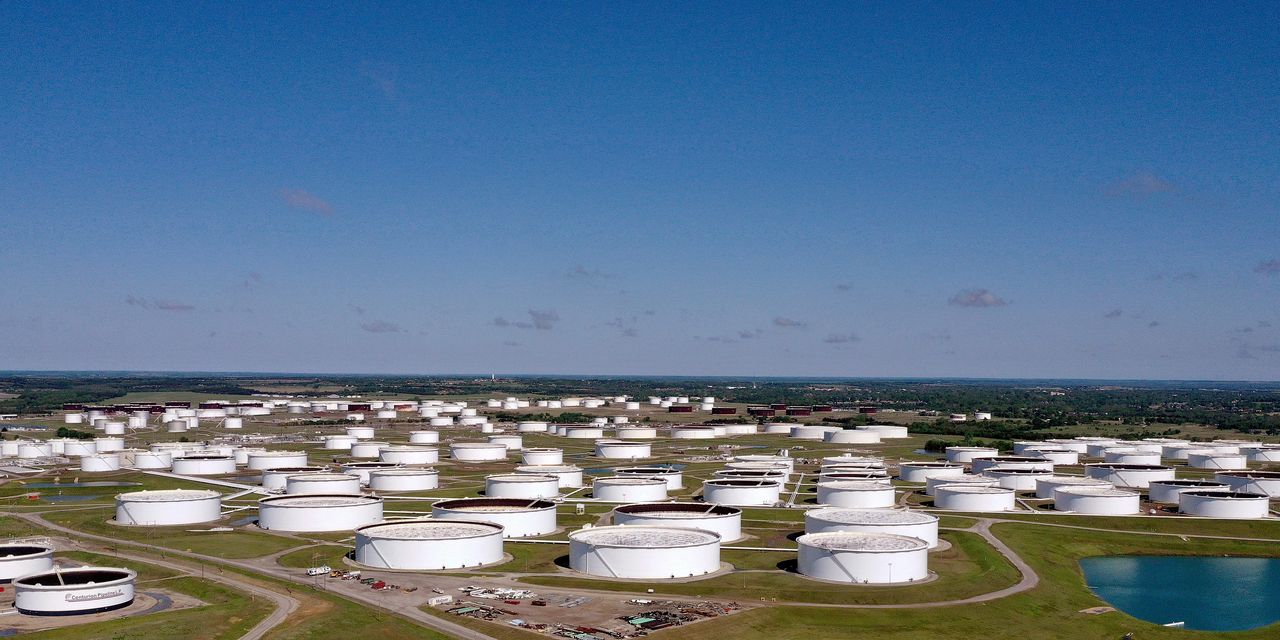Oil futures declined on Wednesday, with U.S. prices settling at their lowest in a month, pressured by continued worries over the demand outlook.
A bigger-than-expected weekly fall in U.S. crude supplies, however, helped to temper the price decline.
Price action
-
West Texas Intermediate crude for October delivery
CL00,
+0.72% CLV23,
+0.72%
fell by 75 cents, or 0.9%, to settle at $78.89 a barrel on the New York Mercantile Exchange. That was the lowest front-month contract finish since July 26, according to Dow Jones Market Data. -
October Brent crude
BRN00,
+0.68% BRNV23,
+0.72% ,
the global benchmark, lost 82 cents, or 1%, at $83.21 a barrel on ICE Futures Europe, the lowest finish since Aug. 2. -
September gasoline
RBU23,
+0.21%
shed 0.7% to $2.77 a gallon and September heating oil
HOU23,
+0.61%
settled at $3.13 a gallon, down 0.3%. -
Natural gas for September delivery
NGU23,
+0.20%
lost 2.5% to $2.50 per million British thermal units, extending its 2.7% loss from a day earlier.
Economic worries
Oil futures marked a three-day losing streak after snapping a string of seven straight weekly gains last week.
“The rally in oil appears to have run out of steam for now. China’s macro issues, along with a growing expectation that maybe the U.S. Fed is not done with its tightening cycle have weighed on oil more recently,” Warren Patterson and Ewa Manthey, commodity strategists at ING, said in a note.
Troubles in China’s property sector have added to concerns over lackluster economic data from the world’s second-largest oil consumer. Investors were awaiting Federal Reserve Chair Jerome Powell’s speech at an annual symposium on monetary policy in Jackson Hole, Wyo., on Friday.
A broadly stronger U.S. dollar is also providing headwinds, the ING strategists said. A stronger dollar can be a negative for commodities priced in the unit, making them more expensive to users of other currencies.
Iran, meanwhile, has quietly increased its output by around 400,000 barrels a day to a little over 2.9 million barrels a day, or mbd, the highest since late 2018, the ING analysts noted, with Tehran saying it aims to hit 3.4 mbd by the end of summer, just shy of its pre-sanction pace of 3.8 mbd.
“Given much of the focus has been on Russian flows since the war, Iran has taken advantage of this to increase oil exports,” Patterson and Manthey wrote.
While crude has pulled back in August after a 15% July rally, oil continues to outperform most assets, analysts at Goldman Sachs wrote in a Wednesday note. Risks to the bank’s year-end target of $86 a barrel for Brent crude have turned “bullish to mixed” over the past month, they wrote.
Their biggest bearish fear — persistently high crude stocks — has diminished, in part due to production discipline by OPEC+ members, including a 1 mbd production cut by Saudi Arabia that began in July and is set to run through September.
“We still assume that Saudi Arabia tapers its 1mb/d extra production cut to 500kb/d in October, but Saudi production could well stay its current low 9mb/d level for longer if Saudi Arabia envisions a more aggressive price target,” the Goldman Sachs analysts wrote.
Also see: Interest in nuclear energy is growing with uranium output lagging demand
Supply data
Traders on Wednesday also digested the latest U.S. petroleum supply report from the Energy Information Administration.
The government agency reported that U.S. commercial crude inventories fell by 6.1 million barrels for the week ended Aug. 18.
Analysts surveyed by S&P Global Commodity Insights, on average, expected the EIA to report a weekly crude-supply drop of 4.24 million barrels. Late Tuesday, the American Petroleum Institute late Tuesday reported a 2.4 million barrel decline, according to a source citing the data.
“Ongoing strength in refining activity and crude exports have encouraged a solid draw to oil inventories, while peak summer refinery runs have resulted in builds for both gasoline and distillates,” Matt Smith, lead analyst for the Americas at Kpler, told MarketWatch.
The EIA report also revealed supply increases of 1.5 million barrels for gasoline and 900,000 barrels for distillates for the week. Analysts had forecast a weekly inventory decline of 1.15 million barrels for gasoline, while distillate stockpiles were expected to be mostly unchanged.
Crude stocks at the Cushing, Okla., Nymex delivery hub declined by 3.1 million barrels for the week, the EIA said.
The data showed a much larger draw “not only in crude oil but also in Cushing,” Tariq Zahir, managing member at Tyche Capital Advisors, told MarketWatch.
He said the recent weakness we have seen in crude oil may “reverse.” With several storms in the Gulf of Mexico region, with a potential of disruption coupled with the ongoing Saudi Arabia reduction in production, we feel that “will lead to the potential risk of higher prices with crude oil in the days and weeks ahead.”
Read the full article here



